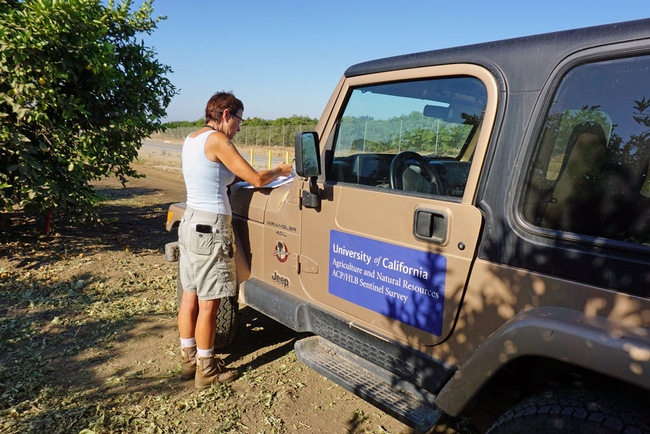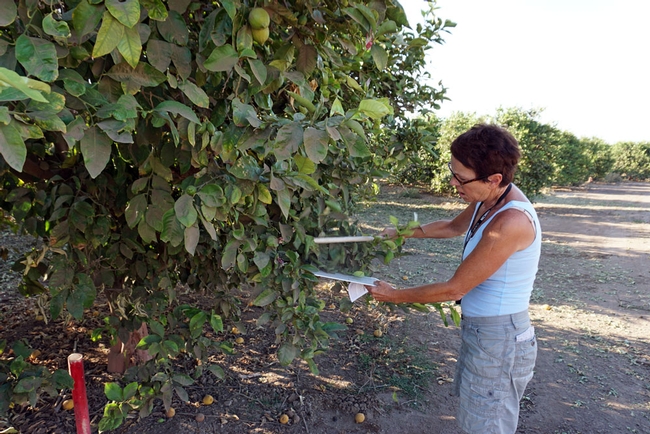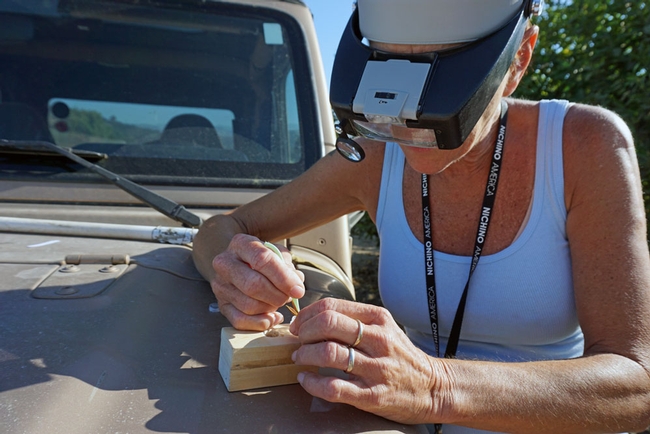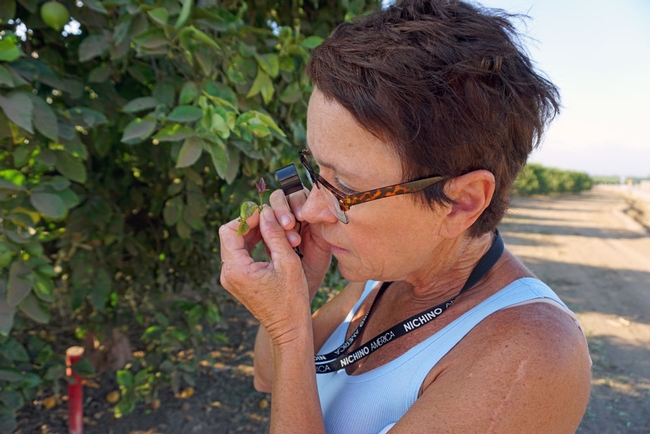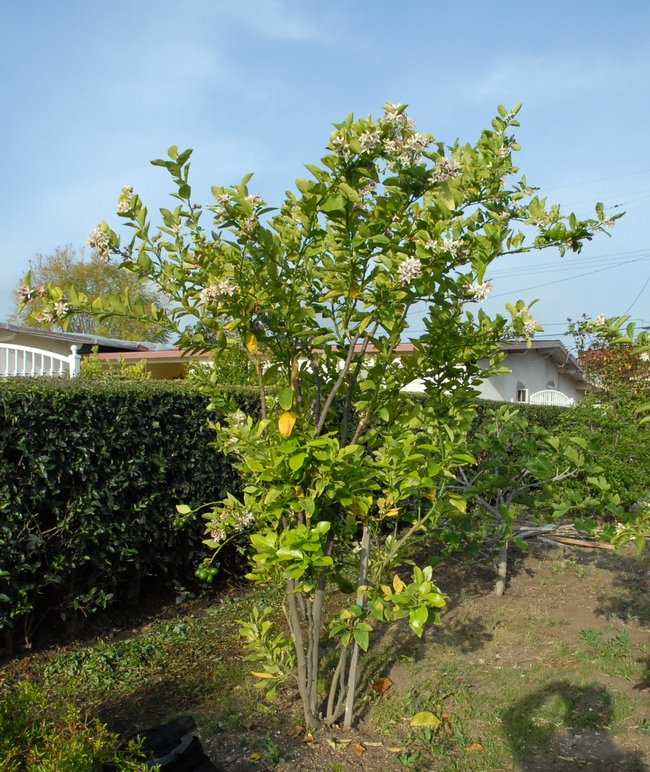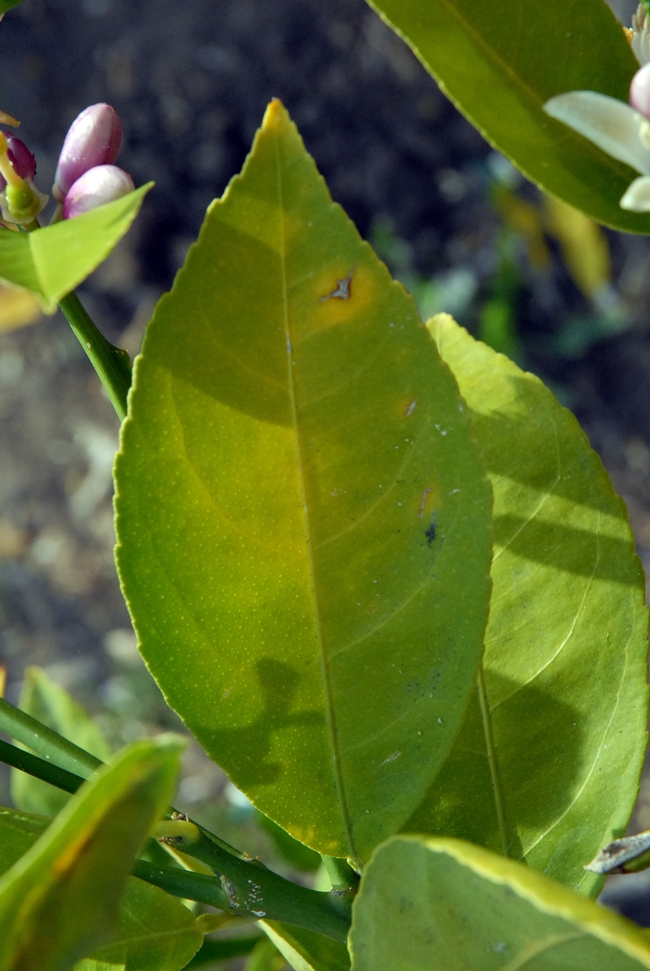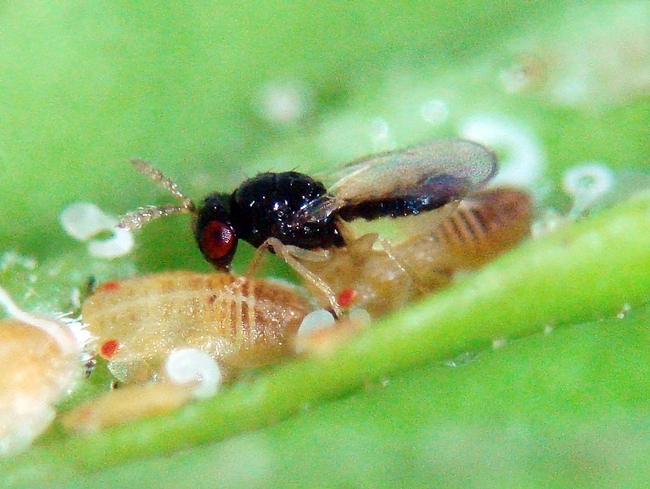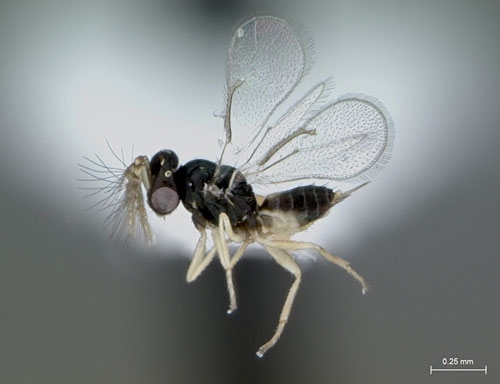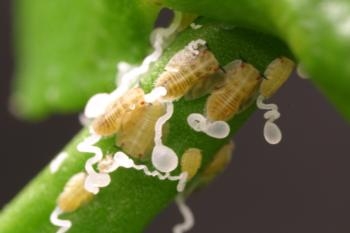Posts Tagged: huanglongbing disease
UC has boots on the ground in an unrelenting search for Asian citrus psyllid
With two magnifying loops around her neck and a truck stocked with vials and tools for insect collection, Joanne O'Sullivan scouts Ventura County citrus orchards every day. She walks the perimeter, examining newly emerging leaves and tapping branches with a PVC wand to bat pests onto her clipboard.
O'Sullivan is one of four scouts hired and trained by UC Agriculture and Natural Resources scientists to carefully and continuously monitor citrus orchards for Asian citrus psyllid, an invasive pest in California that can spread the devastating huanglongbing disease.
In Florida, where the pest was left unchecked when it first invaded citrus growing regions, the disease swept through the state. Citrus production in the Sunshine State plummeted 60 percent in 15 years.
“We don't want to let that happen here,” said Beth Grafton-Cardwell, UC Cooperative Extension entomology specialist. Grafton-Cardwell hired O'Sullivan and her colleagues who monitor citrus in San Diego, Imperial, Riverside and San Bernardino counties to scour dozens of orchards to document how treatments to control ACP are working. Next year scouts will be added in Tulare and Kern counties.
When ACP are found, they are carefully bottled and sent to the lab to determine whether they carry the bacterium that causes huanglongbing disease.
The expansive ACP monitoring effort is funded by a $1.45 million multi-agency coordination grant from the USDA. The project funds promising tools and long-term solutions to reduce the spread of huanglongbing. Led by Neil McRoberts, a professor of plant pathology at UC Davis, the grant also provides funds for two other activities.
One is a collaboration with California Citrus Mutual to offer free citrus tree removal to homeowners in areas where HLB is known to occur. The second is modeling data from the CDFA HLB survey program, in which psyllids and symptomatic plant tissue are tested for the bacteria. Trees may have the disease but not show symptoms, so testing the psyllids is a more effective way to find infected trees. The modeling work will improve the ability to predict the locations of infected trees.
However, the main thrust is monitoring citrus treatments and their impacts on the ACP population with a team of scouts. A mix of conventional and organic farmers and growers who use biological integrated pest management programs to manage their orchards were recruited for the project. The farmers make ACP treatment decisions informed by research results that show the best treatments and timing.
“Most growers are coordinating their treatments to get a bigger bang for their buck,” Grafton-Cardwell said.
With just six months of data, the monitoring program has already yielded important information about Asian citrus psyllid.
“We're seeing more psyllids on the borders than the centers of groves,” Grafton-Cardwell said. “And so eventually, we will make recommendations that at certain times of year or when populations are low, the grower will only need to spray the borders of the grove."
This will reduce costs and the impact of pesticides on natural enemies.
"The early data have also revealed which chemicals are the most effective for psyllid control. We've found that organic growers need to be more aggressive in the frequency of treatments, because the organic insecticides are not as effective as conventional insecticides," she said.
At 8 of the 49 Ventura County ranches in the project, yellow sticky traps were placed in trees to monitor for ACP's natural enemies, including lady bugs, green lacewings, and Tamorixia radiata, tiny wasps from Pakistan that were released in California to battle ACP.
When O'Sullivan sees one of the natural enemies at work in the field, she pauses to observe the process.
“Sometimes I'll see a lacewing munching on an ACP and I'll say, ‘Go man, go!'” O'Sullivan said.
UC ANR scientists urge citrus farmers and backyard growers to be vigilant in face of new disease find
Now that two additional backyard citrus trees in Southern California were found to be infected with the bacterium that causes Huanglongbing (HLB) disease, UC Agriculture and Natural Resources (UC ANR) Cooperative Extension advisors and specialists are encouraging all citrus owners to monitor for disease symptoms and report trees suspected to be infected with HLB to the California Department of Food and Agriculture (CDFA) hotline, (800) 491-1899.
This month, a lime tree and a kumquat tree with HLB were identified in residential areas of the San Gabriel Valley. In March 2012, an infected multi-grafted citrus was found in a Hacienda Heights backyard.
“So far, the bacterium that causes HLB has been found infecting only three trees, which have all been destroyed,” said Beth Grafton-Cardwell, UC ANR Cooperative Extension citrus entomology specialist. “However, it is highly likely there are other infected trees in California. It will be critical for all Californians to assist with efforts to reduce psyllids and detect and remove infected trees to prevent this disease from devastating California citrus.”
An early symptom of Huanglongbing disease is yellowing of leaves on an individual limb or one sector of the tree's canopy, according to a UC ANR Integrated Pest Management Program Pest Note. Leaves that turn yellow from HLB will show an asymmetrical pattern of blotchy yellowing or mottling of the leaves. The Pest Note includes color pictures and detailed symptom descriptions.
HLB disease is spread from tree to tree by Asian citrus psyllid, an invasive insect first identified in California in 2008. ACP has become established in many Southern California communities and is seen occasionally in the state's San Joaquin Valley and Central Coast commercial citrus production areas. Locations where ACP are found are quarantined by CDFA. No untreated or unprocessed citrus fruit and no citrus trees may be moved from these areas. UC ANR maintains an online map that delineates the quarantined locations. The map also shows the area quarantined because of the recent HLB find.
Once a tree is infected with the bacterium that causes HLB, there is no cure. To prevent HLB infections, citrus owners in areas where Asian citrus psyllids are found may wish to treat their trees with insecticides.
“We believe about 60 percent of Californians have at least one citrus tree in their yard, so HLB could have a devastating effect on the California residential landscape,” Grafton-Cardwell said. “There are safe and effective ways to reduce the ACP population, which reduces the chances of losing a tree to HLB.”
Grafton-Cardwell developed a website for farmers and residents with detailed information on managing Asian citrus psyllid. In some urban areas, a natural enemy of ACP, Tamarixia radiata, has been released. In those areas, Grafton-Cardwell recommends the use of “soft” insecticides that will reduce the number of psyllids and allow the Tamarixia to control the rest.
If Tamarixia are not in the area, the website gives information on broad spectrum insecticides to reduce the number of psyllids. The website provides the names of the pesticides, their costs, the duration of control and the effectiveness of the pesticides against ACP.
To help California residents and commercial citrus growers deal with the ACP and HLB citrus threats, UC ANR, UC Davis and UC Riverside scientists are conducting research on a number of possible solutions.
For example, Abhaya Dandekar, professor in the Department of Plant Sciences at UC Davis, and his colleagues are studying gene fusion, which fuses two immunosuppressive genes that attack HLB in different ways to make the plant more effective at fighting the disease.
Mikeal Roose, a professor in the Department of Botany and Plant Sciences at UC Riverside, is working with researchers in Florida to sequence a rootstock that has some natural resistance to HLB and locate the gene or genes that cause HLB resistance.
Mark Hoddle, UC ANR Cooperative Extension biocontrol specialist at UC Riverside, has identified a second natural enemy of ACP from the Punjab, Pakistan. (The first one was Tamarixia radiata.) Populations of Diaphorencyrtus aligarhensis have also been released in urban areas and Hoddle is monitoring the insect's ability to attack ACP.
Because it is important to remove trees infected with HLB as soon as possible to reduce spread, UC scientists are also studying ways to identify trees with the disease before visual symptoms occur.
For example, Hailing Jin, professor in the Department of Plant Pathology at UC Riverside, has identified small RNAs that are induced by the bacterium that causes HLB and could be used for early diagnosis.
Carolyn Slupsky, professor in the Department of Food Science and Technology at UC Davis, has identified metabolites that change in concentration when citrus is infected with the bacterium that causes HLB. She is working with the Citrus Research Board (CRB), CDFA, Texas A&M, and USDA to validate her results and determine how quickly the disease may be detected once the tree has been exposed to the pathogen. She is also part of a USDA collaborative grant to study the vector that transmits the disease to help find ways to stop transmission.
Wenbo Ma, professor in the Department of Plant Pathology Microbiology at UC Riverside, has developed antibodies against proteins secreted by the HLB pathogen – revealing whether the plant is infected. These antibodies have been evaluated in California, Florida and Texas for HLB detection.
An initiative to manage endemic and invasive pests and diseases is part of UC Agriculture and Natural Resources Strategic Vision 2025.
This story is also available in Spanish.
Author: Jeannette Warnert
Parasitic wasps battle Asian citrus psyllid
Western Farm Press ran a detailed update on efforts at UC Riverside to identify and release natural enemies of Asian citrus psyllid to aid in the fight against the feared citrus pest and the deadly citrus disease huanglongbing it carries in other parts of the U.S. and world.
To date more than 160,000 parasitic wasps have been released in over 400 locations spanning 350 zip codes, 64 cities and six counties in southern California, the story said. The counties are Los Angeles, Orange, San Bernardino, Riverside, San Diego and Imperial.
“What was remarkable was we had put out few parasites in relatively few areas (and) they survived just fine,” Hoddle said. “They came through their first winter here in southern California with no problem. That is always the first test: can they survive their first winter?”
Hoddle told Fitchette he is encouraged by the success of the program and by the biological success of the wasp. Since it was first released, it has developed its own breeding populations and has been discovered as far as eight miles away from initial release sites, indicating that it is quite mobile.
Hoddle cautions that the Tamarixia, and another parasitoid called Diaphorencyrtus aligarhensis (Encyrtidae), which could be released in California later this year, are not “silver bullets” in the Asian citrus psyllid/huanglongbing fight. Nevertheless, they do offer hope.
Commercial orchards will continue to spray for the ACP, but urban environments can employ biological control measures when the spray program operated by the state is too expensive to continue.
“As long as we maintain well-irrigated urban environments with plenty of citrus in them the Asian citrus psyllid is going to be here to stay,” he said.
San Diego County neighborhoods to be treated for Asian citrus psyllid
State officials will spray pesticide on residential citrus trees near Fallbrook today (Dec. 17), part of an ongoing effort across Southern California to prevent a devastating citrus disease, reported the San Diego Union Tribune.The pesticide application targets Asian citrus psyllid, which can transmit huanglongbing disease.
Residents in the area have been notified, said Steve Lyle, spokesman for the California Department of Food and Agriculture. He said officials have used the same preventive approach in San Diego County since 2008, when the pest was first discovered locally.
Union Tribune reporter Chris Nichols added information in the article from UC's Asian citrus psyllid and huanglongbing disease website.
"The Asian citrus psyllid is a brown insect about the size of an aphid. It attacks new citrus leaf growth and causes the new leaf tips to twist or burn back. Most concerning, it can spread bacteria that cause a citrus-greening disease known as Huanglongbing or HLB, according to a description on the University of California’s Agriculture and Natural Resources website," the reporter wrote.

